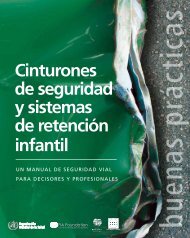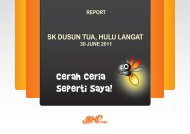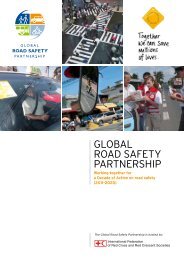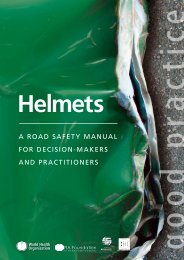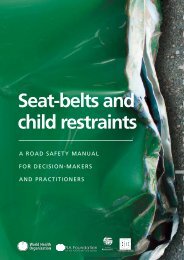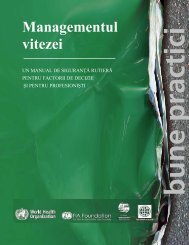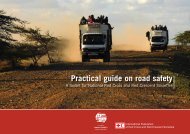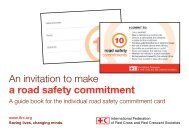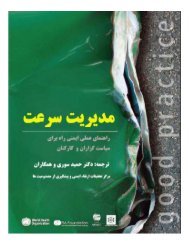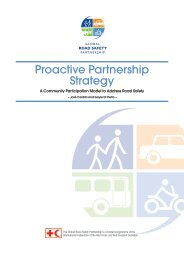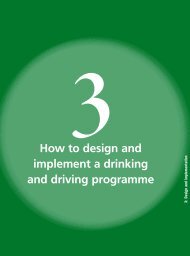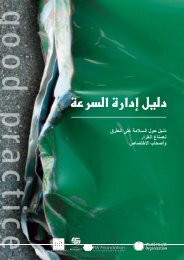How to evaluate the programme - World Health Organization
How to evaluate the programme - World Health Organization
How to evaluate the programme - World Health Organization
You also want an ePaper? Increase the reach of your titles
YUMPU automatically turns print PDFs into web optimized ePapers that Google loves.
Helmets: a road safety manual<br />
measure for evaluations of mo<strong>to</strong>rcycle crashes where lifelong disability resulting from<br />
serious head injury is an outcome.<br />
4.2.5 Determining sample size<br />
For all quantitative study types it is important <strong>to</strong> have sufficiently large numbers in<br />
<strong>the</strong> study <strong>to</strong> be sure that if an effect exists it is detectable. The rarer <strong>the</strong> event, <strong>the</strong><br />
greater <strong>the</strong> sample size needs <strong>to</strong> be in order <strong>to</strong> detect a difference. Serious injuries<br />
from mo<strong>to</strong>rcycle crashes are relatively rare events and a study using serious injury or<br />
death as an outcome would involve a large sample size. Measuring helmet-wearing<br />
rates requires a smaller number of participants.<br />
4 | <strong>How</strong> <strong>to</strong> <strong>evaluate</strong> <strong>the</strong> <strong>programme</strong><br />
Fac<strong>to</strong>rs that must be taken in<strong>to</strong> consideration in determining <strong>the</strong> sample size are <strong>the</strong><br />
expected size of <strong>the</strong> effect <strong>to</strong> be detected, variability in <strong>the</strong> measures, and <strong>the</strong> prevalence<br />
of <strong>the</strong> variable of interest. For a cluster randomised trial, sample size calculations<br />
will also take <strong>the</strong> size of <strong>the</strong> cluster and correlation within clusters in<strong>to</strong> account.<br />
For fur<strong>the</strong>r information on sample size calculations for cluster randomised trials see<br />
reference 14.<br />
Sample size calcula<strong>to</strong>rs are freely available on <strong>the</strong> internet, but it is wise <strong>to</strong> consult a<br />
statistician regarding such estimates, particularly where cluster randomised trials or<br />
random and/or stratified samples are necessary.<br />
Economic evaluation<br />
A study was carried out <strong>to</strong> compare cost effectiveness for three different <strong>programme</strong>s<br />
aimed at increasing bicycle helmet use in children between <strong>the</strong> ages<br />
of 5 and 16 (a legislative <strong>programme</strong>, a community-based <strong>programme</strong> and a<br />
school-based <strong>programme</strong>). Over a four-year period, it <strong>to</strong>ok account of <strong>the</strong> direct<br />
costs of <strong>the</strong> <strong>programme</strong> (costs of helmets and o<strong>the</strong>r programmatic costs) and<br />
<strong>the</strong> savings in health care expenditures due <strong>to</strong> prevention of bicycle-related head<br />
injury. The outcomes were head injuries prevented, deaths averted and years of<br />
life saved and were modelled on <strong>the</strong> basis of avoided cases, expected cases,<br />
increased risk of bicycle-related head injury from not wearing a bicycle helmet<br />
during a crash, and <strong>the</strong> pre- and post-intervention prevalence of not wearing a<br />
helmet. Overall, <strong>the</strong> legislative <strong>programme</strong> appeared <strong>to</strong> be <strong>the</strong> most cost effective,<br />
followed by <strong>the</strong> community-based <strong>programme</strong> and <strong>the</strong>n <strong>the</strong> school-based<br />
<strong>programme</strong> (15).<br />
Links <strong>to</strong> online sample size calcula<strong>to</strong>rs may be found at http://calcula<strong>to</strong>rs.stat.ucla.edu/sampsize/php or<br />
alternatively <strong>the</strong> statistical package Epi Info may be downloaded at http://www.cdc.gov/epiinfo/<br />
A sample size calcula<strong>to</strong>r for cluster randomised trials may be found at www.abdn.ac.uk/hsru/epp/cluster.shtml<br />
135



